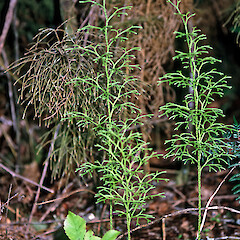Pseudolycopodium densum
Common name
clubmoss
Synonyms
Lycopodium deuterodensum Herter; Lepidotis densa Rothm.; Lycopodium densum Labill.
Family
Lycopodiaceae
Flora category
Vascular – Native
Endemic taxon
No
Endemic genus
No
Endemic family
No
Structural class
Lycophytes (clubmosses, selaginella, quillworts)
NVS code
The National Vegetation Survey (NVS) Databank is a physical archive and electronic databank containing records of over 94,000 vegetation survey plots - including data from over 19,000 permanent plots. NVS maintains a standard set of species code abbreviations that correspond to standard scientific plant names from the Ngä Tipu o Aotearoa - New Zealand Plants database.
LYCDEU
Chromosome number
2n = 68
Current conservation status
The conservation status of all known New Zealand vascular plant taxa at the rank of species and below were reassessed in 2017 using the New Zealand Threat Classification System (NZTCS) – more information about this can be found on the NZTCS website. This report includes a statistical summary and brief notes on changes since 2012 and replaces all previous NZTCS lists for vascular plants.
Please note, threat classifications are often suggested by authors when publications fall between NZTCS assessment periods – an interim threat classification status has not been assessed by the NZTCS panel.
- Conservation status of New Zealand indigenous vascular plants, 2017 . 2018. Peter J. de Lange, Jeremy R. Rolfe, John W. Barkla, Shannel P. Courtney, Paul D. Champion, Leon R. Perrie, Sarah M. Beadel, Kerry A. Ford, Ilse Breitwieser, Ines Schönberger, Rowan Hindmarsh-Walls, Peter B. Heenan and Kate Ladley. Department of Conservation. Source: NZTCS and licensed by DOC for reuse under the Creative Commons Attribution 4.0 International licence.
2017 | Not Threatened | Qualifiers: SO
Previous conservation statuses
2012 | Not Threatened
2009 | Not Threatened
2004 | Not Threatened
Distribution
Indigenous. New Zealand: North Island (from North Cape to Lake Taupo and nearby river catchments), Chatham Islands. Also Australia and New Caledonia.
Habitat
Coastal and lowland forests in gumland scrub, on forest margins and ridgelines (especially in kauri forest), or in open clay pans within tall forest.
Detailed description
Rhizome creeping, to 3 m long, clothed in slightly spreading scale leaves. Branchlet systems erect, 0.1–1.0 m tall. Leaves spiral to subwhorled, imbricate, appressed or spreading, adnate, dimorphic, green, yellow-green to yellow. Leaves of sterile branchlets linear-lanceolate, attenuate, 2.0–4.5 mm long, spreading. Leaves of sporogenous branchlets ovate-lanceolate, attenuate, 1.0–2.5 mm long; margins membranous, translucent, ciliate around the base. Leaves of central axis (sporogenous and sterile) similar to those of sterile branchlets, but appressed, 4.5–6.0 mm long. Strobili terminal on ultimate branchlets, 10–35 mm long, solitary. Sporophylls imbricate, acute; margins membranous, fimbriate. (Description adapted from Chinnock (1998) and Brownsey & Smith-Dodsworth (2000)).
Similar taxa
None. Easily recognised by the stout, erect, aerial branches which resemble a small conifer. Pseudolycopodium densum could possibly be confused with Austrolycopodium fastigiatum except that, A. fastigiatum is a species of montane habitats (it is never found growing with Pseudolycopodium densum), and the leaves on the branchlets of fertile specimens are not appressed as they are in P. densum.
Flowering
Not applicable (spore producing)
Flower colours
No flowers
Fruiting
Not applicable (spore producing)
Propagation technique
Can be grown with some difficulty. Best results have been achieved with plants grown on untreated saw dust.
Where To Buy
Not Commerically Available
Attribution
Fact sheet prepared for NZPCN by P.J. de Lange 17 March 2011. Description adapted from Chinnock (1998) and Brownsey & Smith-Dodsworth (2000).
References and further reading
Brownsey PJ, Smith-Dodsworth JC. 2000. New Zealand Ferns and Allied Plants. David Bateman, Auckland, NZ. 168 p.
Chinnock RJ. 1998. Lycopodiaceae. Flora of Australia 48, Ferns Gymnosperms and allied groups: 66–85. ABRS/CSIRO Victoria, Australia.
NZPCN Fact Sheet citation
Please cite as: de Lange, P.J. (Year at time of access): Pseudolycopodium densum Fact Sheet (content continuously updated). New Zealand Plant Conservation Network. https://www.nzpcn.org.nz/flora/species/pseudolycopodium-densum/ (Date website was queried)



